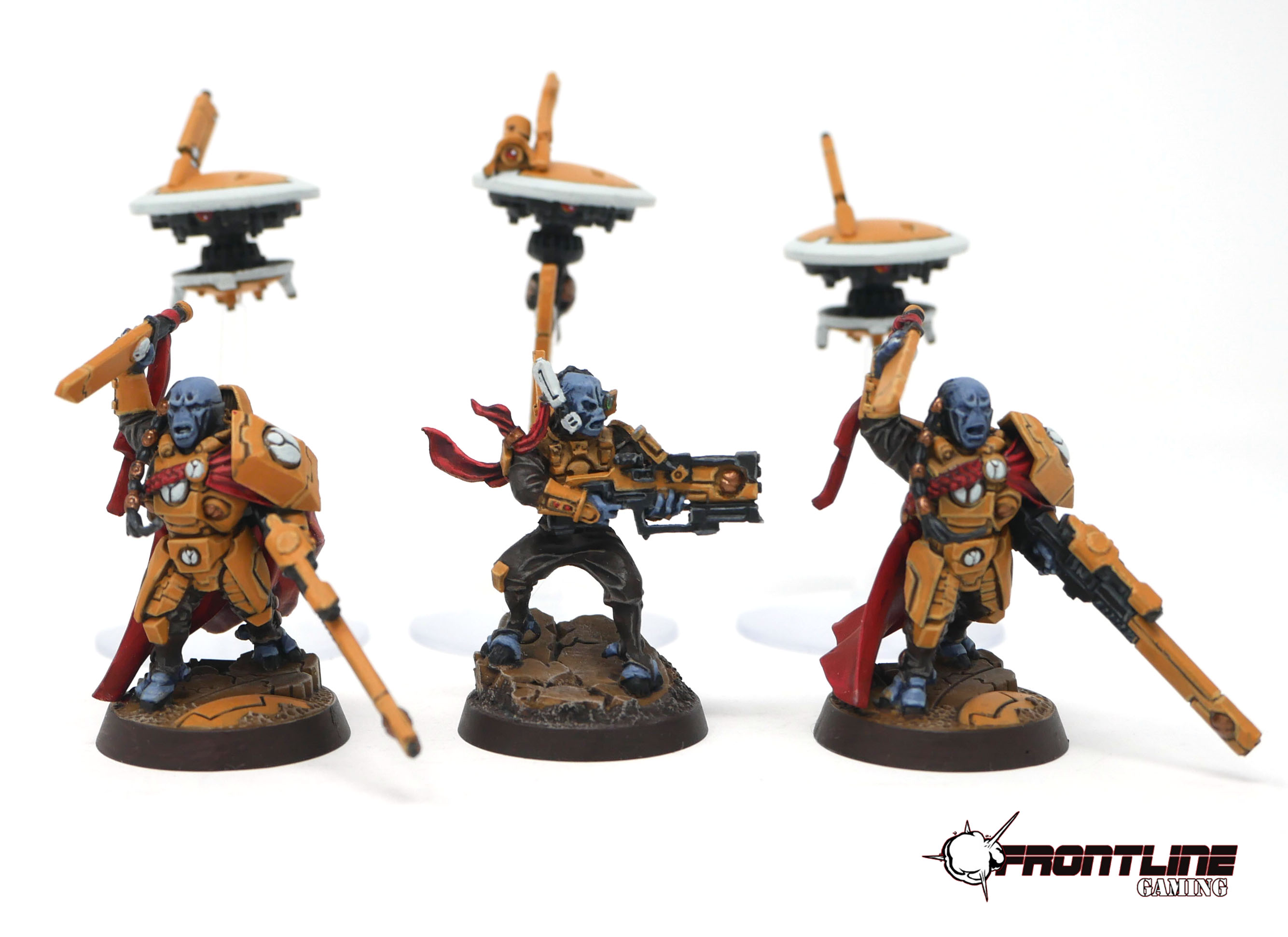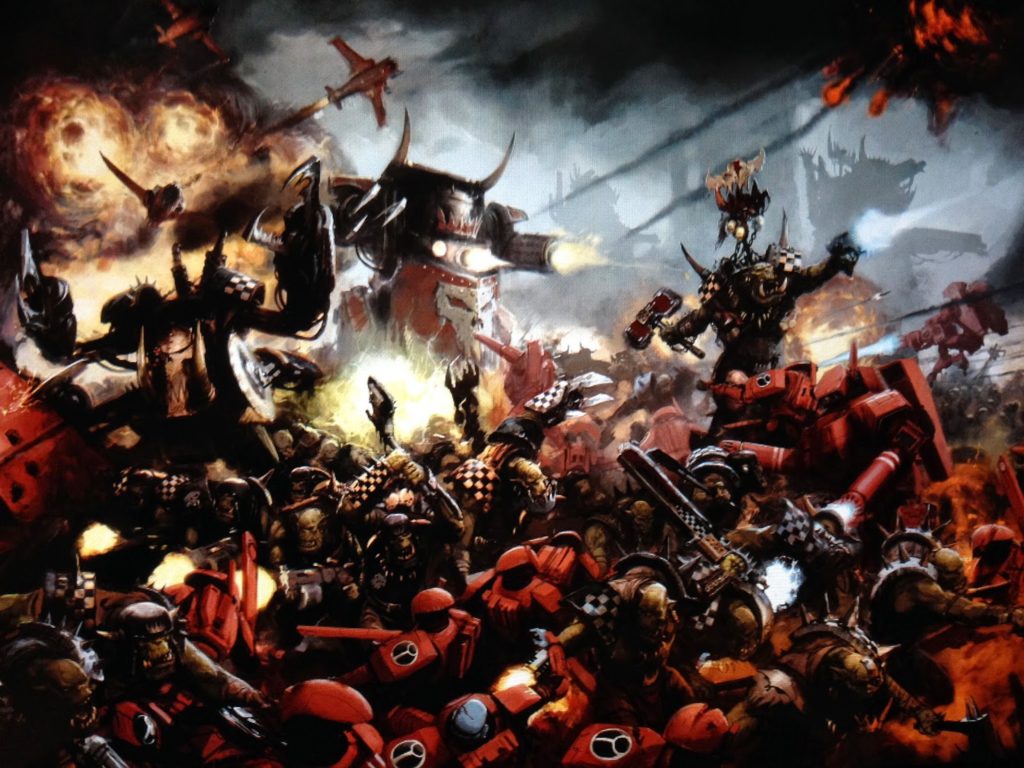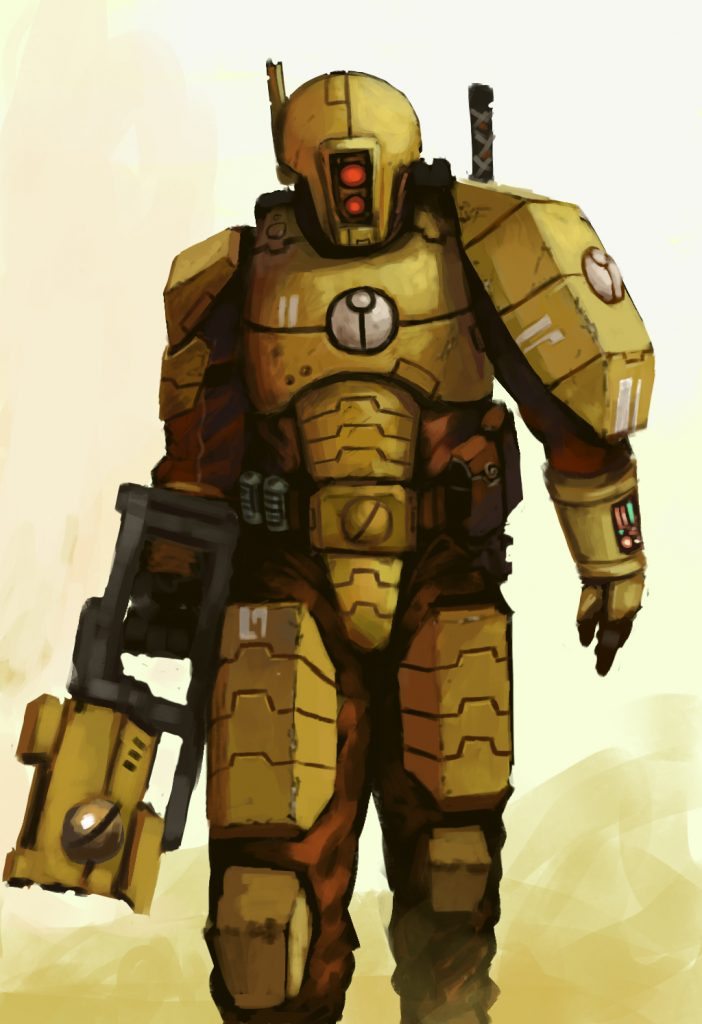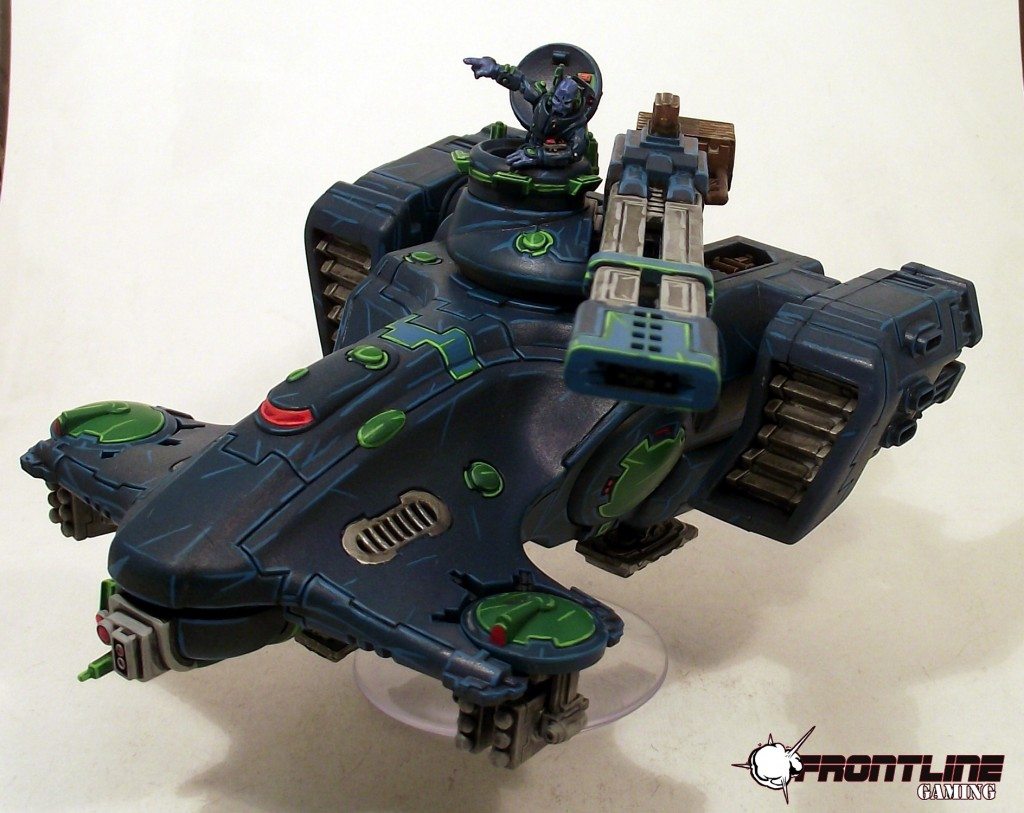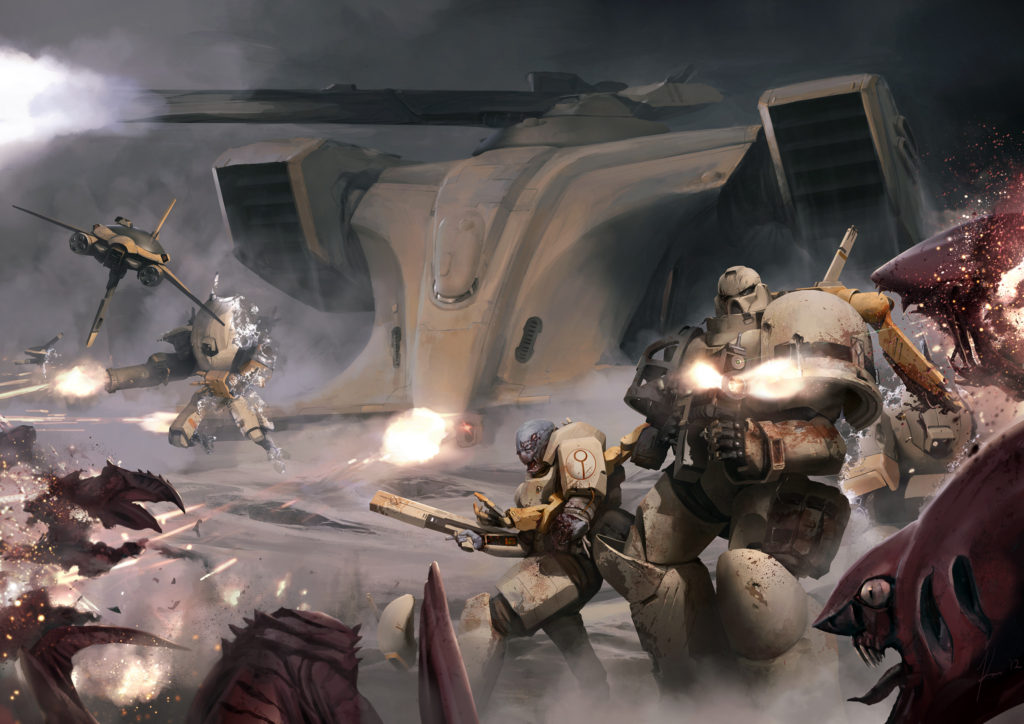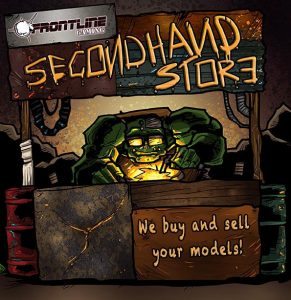Today we take a deeper dive into the six major (and innumerable minor) septs of the Empire and look at them each in turn. Click to read on, or check out the Tactics Corner for more reviews and strategies.
Last week we talked about the general rules of the T’au Empire codex; this time, we’ll be looking in a little more detail at the first of the major choices you’ll need to make when selecting an army- namely, which Sept world your force will hail from. As per the new Nachmund tournament pack rules, you can only select one Sept for your entire force, so no more mixing and matching to try and sneak out the benefits of all of them- although there are a few small exceptions to this for certain named characters.
As with previous books, the Sept you pick will determine not only an army-wide benefit that applies to all units other than Kroot and Vespid, but also will give you access to a unique warlord trait, relic, and stratagem that other Septs won’t have available. You can also build a “custom” Sept if you feel the six main ones don’t accurately reflect your world’s battle tenets, although typically this is not the strongest competitive option, as you don’t get access to the unique traits/stratagems/relics this way. We’ll discuss those options at the end of the article.
Compared to previous iterations of the codex, the Sept tenets are much better balanced against each other- although there are some clear standouts, each of the Septs has at least some argument in favor of it and dictates a clear playstyle where it is advantaged over the others. I think two of the Septs (Tau and Farsight) will clearly stand out to competitive players over the others, but even those aren’t without use cases and if you’re playing in a pickup game running one of the others isn’t going to feel like you are being punished. So let’s go ahead and take a look at what each of them have to offer.
T’au Sept
The largest of the Septs in the empire and the most iconic, Tau Sept sets the standard for the rest of the colonized worlds and leads by example. Its Sept tenet is simple but effective- each time a Tau unit shoots or fights, it can reroll either one hit roll or one wound roll, and each time it uses a command phase ability or aura, the range of that ability increases by 3″. Although neither of these are particularly flashy, their universal applicability and broad mechanical efficiency mean that it is very hard to go wrong with Tau Sept. The rerolls are particularly effective with the low-volume high-quality weapons that can be found around the codex as well as for any MSU strategies, both of which are going to be big players this time around- reolling a Rail weapon shot into a successful wound (and mortal wound) is going to feel great every time. The range increase, meanwhile, may not feel like a lot but 3″ extra actually translates into way more area covered by such abilities- going from 6″ to 9″, for example, means covering more than double the total space on the table. And make no mistake about it- Tau have a lot of auras and command phase abilities these days, including reroll auras of commanders, warlord trait abilities, and more. Ask any Sisters player and they will tell you just how valuable that increase to your auras can be, and Tau will be little different.
The Tau warlord trait, sadly, is a bit underwhelming, granting a 5+ ability to shrug off wounds taken. This certainly isn’t bad, and combined with an Enforcer Commander wearing the Be’gel Plate and one of the defensive Prototype systems, it can make you almost comically resistant to damage- however, a Commander’s main duty is not staying alive, it is winning fights, and this really doesn’t do a lot for you in that regard.
Their relic, thankfully, is better, because it enables some serious shenanigans. Vectored Maneuvering Thrusters (bizarrely not locked to just Commanders, so give your Fireblade a jetpack I guess) let you make an immediate normal move upon being charged- though only once per turn. The enemy is allowed to redirect their charge into other units if you want, and you can’t fire overwatch with the character if they choose to move. It also adds 2″ to the character’s normal move, as if all that weren’t enough. Although it has a lot of competition, I think the Vectored Thrusters will be a prime choice because Tau just really don’t like being in combat and this helps ensure you don’t have that problem.
Rounding things out, the Tau strategem is arguably the best part of their kit- Focused Fire. For 2CP, when one of your Tau models inflicts an unsaved wound on the enemy you can pop the strat and for the remainder of the phase all your Core models will have +1 to wound against that target. This stratagem was amazing back in 8E when they first got it and it remains so now- it helps push through wounds on a target that needs to die whether small or large and makes your Pulse Rifles extremely threatening to any unit in the game. Note that due to a small change in wording (specifically the removal of the word “other” from the text) it now applies to the unit that inflicted the initial unsaved wound, meaning you are strongly incentivized to slow-roll your attacks when using it.
I think Tau Sept is going to be the premiere choice for most armies, or at the very least one of the two premiere choices- their powerful trait combined with excellent unique options put them in a prime choice for building an army and their flexibility means they can be taken in many different directions as desired. Also importantly, they have access to far more named characters than any other sept- Longstrike, Darkstrider, Shadowsun and Aun’va are all part of the Tau Sept and although the latter two can potentially be taken in any army, they still function best within Tau.
Vior’la
From Tau we take a huge step down, unfortunately, into the next sept on the list. Vior’la units add +2″ to their movement on the first turn if they start within their deployment zone, and can reroll all advance and charge rolls. The first part of their bonus is extremely transient and, though it does reward the aggressive playstyle, it just doesn’t feel like enough to really compare to the others. Rerolling advances and charges, meanwhile, is certainly a nice bonus but Tau aren’t typically doing a lot of voluntary assaults, even with the new codex, and there are several ways to maximize the advances on your most critical units already in the book. Vior’la sadly ranks as pretty easily the worst of the basic sept tenets.
It’s not all bad news, however, as their warlord trait (Academy Luminary) is fairly decent. Any time you use a Strategic Ploy or Wargear stratagem you roll a die for each CP spent and regain it on a 3+, though obviously you are still limited to 1CP per round in a matched play game. This is a fairly solid ability to have around, as Tau definitely can throw out a lot of stratagems in short order, and combined with Puretide Chip it means you are practically guaranteed to gain a CP every turn of the game. It is also the fixed trait on Aun’shi, which makes him slightly more attractive.
Their relic is also solid, although perhaps not quite as good overall. Automated Armor Defenses can only be taken on a Commander and lets you roll a die at the start of your shooting phase- on 2-4 the nearest visible unit in 18″ takes one mortal wound, and on a 5-6 the nearest visible unit within 12″ instead takes d3 mortal wounds. This loses a bit of value for not being during a non-shooting phase of the game, as Tau would greatly prefer to inflict some damage elsewhere in order to bypass C’tan and whatnot, but it’s still free mortal wounds and that’s hard to say no to.
The Vior’la stratagem, however, is the biggest draw for the sept. Hot Blooded is 2CP and is used when you shoot with a Vior’la unit; each time you roll a 6 to wound with that unit, the target takes a mortal wound in addition to anything else (although it doesn’t apply to Drones in the unit.) This sort of stratagem is always powerful and with many setups will practically guarantee six mortal wounds coming out, which is bad news for virtually anything that is getting shot.
Overrall Vior’la suffers heavily compared to the other septs, but it isn’t so bad as to be completely unusable- the strong warlord trait and strat both do some significant work in making up for the weak sept tenet, so don’t be completely shocked if you see some Vior’la armies running around every once in a while, especially at lower point totals.
Sa’cea
Nominally the masters of urban warfare but better known as “the one no one is sure how to pronounce,” Sa’cea was often seen in limited numbers as an ally detachment previously but rarely as a main force. With Tau sept having stolen their reroll gimmick, Sa’cea is now reconceptualized as more defensively-oriented; your units get the standard “count as being in dense terrain if outside of 12 (or 18 if you are a vehicle)” bonus seen in many armies. Vehicles and battlesuits also don’t get the -1 penalty for firing heavy weapons while engaged, giving Sa’cea some decent legs in both long- and short-ranged engagements.
The Sa’cea warlord trait is also quite strong- during your command phase you pick one unit within 9″ to gain ObSec, and if they already have it their models are instead counted twice when determining control of objectives. Scoring is still a significant issue for Tau and although there are certainly ways to enhance it, having a game-long and highly-flexible one like this is extremely powerful.
The relic is somewhat niche, but does have uses- the Grav Inhibitor Field makes all enemies in engagement distance of the character fight last, and gives melee attacks on them -1 to hit. Although Tau typically aren’t much good in a fight, a properly-kitted Enforcer can be a real beatstick, so putting this on someone with the Thermoneutronic Projector can make them into a real hassle to deal with. Don’t sleep on the power of this relic if you are going Sa’cea.
Lastly, the Sa’cea strat is Orbital Uplink, which is short and sweet. For a mere 1CP, you choose an enemy unit and when you shoot at it, they don’t get the benefit of cover. With the loss of Markerlights allowing you to ignore cover this is a much bigger deal than it previously was, but much more critically this stratagem does not let you ignore light cover, it lets you ignore the benefits of cover. That also means dense cover- no more -1s to hit. Sadly it will not allow you to bypass obscuring terrain, but it is still a fantastic stratagem to have and is as cheap as you could possibly hope for.
Sa’cea is definitely a useful sept and its strong defensive abilities make it a prime choice for an army that is trying to take advantage of Kauyon; if the meta evolves in a direction that prioritizes shooting engagements much of the time, Sa’cea is in a good place to be one of the best septs in the codex, although I think at the current time it probably doesn’t quite make that list.
Dal’yth
Dal’yth is all about infantry friends- it gives all of your infantry units cover against shooting attacks (unless they are engaged with that enemy) and it lets your auxiliary units take advantage of Kauyon and Mont’ka. Although neither of these are hugely impressive buffs, they definitely are fairly nice- most units in a Tau army are going to be infantry by default (especially since most battlesuits are now infantry) and making your allies hit a bit harder is a nice tack-on bonus.
Their warlord trait reinforces these themes, giving out two benefits to units within 6″- +1 leadership, always handy for avoiding morale and especially so with the loss of Bonding Knives, and also auxiliary units in range gain the ability to use Markerlights. Unfortunately your auxiliary units are probably not going to be particularly close to your warlord, as Kroot can move very quickly and Vespid like to arrive from the skies, so overall the trait ends up being probably a bit too awkward to use most of the time- still, it’s a nice thought.
The relic for Dal’yth is quite handy- a model with the Dynamic Mirror Field can’t be targeted by shooting unless it is the closest model or within 12″, and they gain a 5+ invulnerable save. Allowing a character to set out on their own is very powerful, as the whole of 8th edition demonstrated, and a Commander with this upgrade can roam at will through the backfield while being equipped with long-range weaponry to harass the enemy.
Their stratagem is an interesting one. Outflank, for 1CP, lets you pick a Core or Auxiliary unit within 9″ of a board edge and put them into strategic reserves- this gives you some serious flexibility in redeploying units and late-game play, but I wonder just how often it will actually get used. Still, it’s a strong tool to have around and you can really catch people off-guard with it.
Overall Dal’yth feels fairly middle of the road as far as septs go- it’s not worthless, but neither is it particularly impressive for the most part. You’ll probably feel fine about playing them as their faction bonus will come into play virtually all of the time, but it may not feel like enough that it is actually tilting the game in your favor.
Bor’kan
The craftsmen and engineers supreme in the Empire, Bor’kan’s benefits are all about superior weaponry. They add 4″ to the range of all weapons they use, which can be especially valuable given the rather short reach of many of the best Tau guns, and they also subtract one from the strength of all S7 or lower weapons that target a vehicle or battlesuit. The strength penalty is at its strongest on light/medium battlesuits, where pushing those S4, S5, and S6 weapons down a tier will feel extremely powerful; it also helps some on Devilfish and other medium vehicles, although it probably won’t feel as impressive there.
The warlord trait is an interesting one- Seeker of Perfection gives all of the warlord’s weapons an extra point of AP and causes 6s to wound do one mortal to the target (maximum of three.) The bonus is definitely significant enough that it can tilt the math on many things, especially on a unit that is carrying high-RoF weapons such as Burst Cannons and using Mont’ka. However, I think that the math overall works out better when using the Precision of the Skilled Hunter trait for full rerolls, sadly leaving this one without a home most of the time.
Their relic is also a bit lackluster overall- you pick two of the model’s weapons, which get +1 to wound against targets in half range. Although it doesn’t take up a weapon slot itself, not applying to all of the model’s guns and only giving a fairly weak bonus overall makes it not particularly attractive given some of the other relic options you have.
The stratagem, however, redeems everything. Experimental Weapons costs 2CP and only works on one gun on one of your models- but that one gun ignores all invulnerable saves on the target. When used on something like Riptide, Stormsurge, or Broadside this can cause immense havoc with their main gun, especially if you are sporting a full set of hit/wound bonuses and rerolls. It isn’t something you will use all of the time, but being able to simply cut down 1-4 Custodes models or blast a lone Hive Tyrant into smithereens is an amazing feeling and will cause no end of salt. Just watch out for those 1s.
I think overall I would rank Bor’kan towards the top of the septs, although not quite with the top two- but its powerful niche means that if you are running heavy on vehicles or huge suits it can do some incredible work in just vaporizing targets as needed.
Farsight Enclaves
The last of the default septs, and in my list of the two most powerful alongside Tau. The Farsight bonuses are very similar to their most recent iteration- if you are within 12″ of the enemy you automatically count as having a markerlight, and you can reroll a single wound roll each time you shoot or fight. The latter part is very nearly as good as the Tau sept ability, and the former part frees you up from having to build markerlights into much of your list, giving you more mobility and more firepower. Farsight Enclaves can also take two Commanders per detachment (rather than one), but cannot take any Ethereals at all.
Their warlord trait also has a strong potential for use- Master of the Killing Blow prevents the enemy from using any abilities that would ignore or negate wounds against the warlord’s attacks, and on a 6 to wound it improves the AP by three. The AP increase is a nice bonus for general use, but the real value is for bypassing models that try to stay alive via shenanigans- such as C’tan and Ghazghull. Slam the rest of your army into them, hit that four-wound limit, and then fire your warlord to chew off the rest.
The Farsight relic is probably the weakest part of the sept, giving the bearer a single Deny the Witch attempt with a +1 bonus. It may sometimes come in handy when your opponent is trying for psychic secondaries or have a clutch power you need to turn off, but it will just be dead weight in too many games and even in ones where it is active it won’t be effective enough to justify, I think.
Lastly, the Farsight stratagem is Drop Zone Clear, which costs either 2 or 3CP You use it on a squad that has arrived by Manta Strike (or Homing Beacon) and they get full rerolls to hit and wound for that turn; you pay the big cost for 4+ battlesuits in the unit, or the lesser cost otherwise. This is a straight upgrade on a stratagem that all septs have access to, and on a 3man Crisis team it can make them to an incredible amount of work the turn they arrive for a relatively small cost. Best of all, it lets you potentially power up two different units arriving in the same turn with the two different stratagems.
I think Farsight Enclaves is in a very prime position to be either the best or second-best sept choice, since it has a great named character, excellent strat, useful warlord trait, and powerful sept tenet in addition to some unique detachment abilities that work out quite well. Although playing Enclaves heavily pushes you towards selecting Mont’ka most games, this is hardly a bad thing given that it is the more powerful of the two Philosophies and there is some really incredible potential for a Tau alpha strike list out there, if you are willing to risk it.
Custom Septs
In addition to the six main septs, there are also custom septs that allow you to pick two abilities off of a list in order to represent one of the smaller Tau worlds. However, it is actually slightly more complicated than that- there are five “sectors” (A, B, C, D, and E) and you can pick one trait each from two different sectors- however, the two sector abilities you pick need to be adjacent to each other. A border all of the others and so can be combined with anything, but B and C border only each other and A, while D and E likewise border each other. There are a few powerful options here, but for the most part I don’t think most of the abilities will be all that enticing.
One other note- instead of picking from the below traits, you can instead choose one of the six named septs and use their bonus for your own. This is most relevant because if you pick Farsight Enclaves, you can get their two abilities (free markerlights, reroll one wound) without the other advantages/disadvantages (no ethereals, double commanders). This could very well be the “superior” version of FSE for a time, although that still remains to be seen.
Sector A
- Play Their Part: Battlesuits count as three models (or five for 10+ wounds) when controlling objectives
- Adherent to the Teachings: +3″ range on abilities in the command phase
- Calm Under Pressure: +1Str for assault weapons while within 12″ of the target.
There are a couple interesting options here, most notably Calm Under Pressure- Tau have an abundance of good Assault weaponry, including on battlesuits, drones, and troops, and this can make things into real killers. Bringing Pulse Blasters to S7, Pulse Carbines and Burst Cannons to S6, Missile Pods to S8, and Plasma to S9 is absolutely no joke.
Sector B
- Camouflage Experts: Dense cover for infantry outside of 12″
- Defensive Doctrines: AP-1 and AP-2 weapons count as AP0
- Blocking Tactics: When your Core Infatry make a charge move, they gain ObSec until your next turn (or count as double)
- Fire Caste Marksmen: 6s to wound with Pulse weapons improve their AP by one
Defensive Doctrines is notable here as it can protect you against a lot of the lighter infantry that otherwise can do significant harm; sadly, it doesn’t have another great defensive trait to combine with from either of its adjacent sectors, although Evasion Maneuvers has some potential there. Blocking Tactics also feels like there is the potential for an interesting list around it, as combining it with Play Their Part could make for a Crisis or Stealth squad that just absolutely bodies an objective.
Sector C
- Evasion Maneuvers: When your Fly units advance, they gain a 5++ against shooting
- Pinpoint Targeting: When you make a ranged attack within 12″, you ignore light cover
- Disengagement Protocols: When your Infantry fall back, roll a d6 for each unit they are engaged with. On a 2+ they take one mortal wound, on a 6+ they take d3 instead.
Evasion Maneuvers is for sure the standout here, as a 5++ is absolutely great and combined with Mont’ka you can essentially get it on much of your army for free. Most amusingly, it actually applies to drones, making your gun drones comically hard to kill.
Sector D
- Reliable Weaponry: Reroll one wound roll each time a unit shoots.
- Defenders of the Cause: Each time a non-drone model takes a mortal wound, ignore it on a 5+.
- Reinforced Armor: S7 or lower attacks against vehicles and battlesuits have -1Str.
- Hardened Warheads: Attacks with Missile weapons ignore cover.
Nothing in this sector really stands out as a big build-around, although there are several nice options to pair with other stuff from other sectors. Reliable Weaponry and Reinforced Armor are both nice options to have if you want.
Sector E
- Turbo-Jets: Add 2″ to the move characteristic of Fly units.
- Loyal to the End: +1 Leadership, reroll morale checks.
- Rapid Retreat: When a unit falls back, add 3″ to their movement.
- Enriched Reactors: ha ha WHAT wait no don’t don’t ever do this no
A few mildly interesting options here, but overall pretty easily the worst of the sectors. Enriched Reactors is so bad I’m not even going to print what it does here, because it really is just that offensive.
Final Thoughts
The sept bonuses from the new Tau book are reasonably well-balanced overall; I think perhaps they could’ve done a little more for some of the septs, but none of them feel like true bottom-tier garbage, as even Vior’la is redeemed by its excellent stratagem and warlord trait. The “named” septs all stand out as the most common choices, with the build-a-sept options being decent and interesting but not your go-to choice in most cases, which is sort of what things should be. Next week we’ll look at the Tau stratagems and pick out some of the big changes as well as some of the new options added.
As always, remember that you can get your wargaming products at great discounts every day from the Frontline Gaming store, whether you’re looking to start a new army or expand an existing one.

